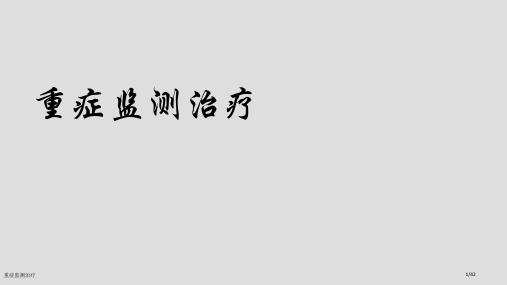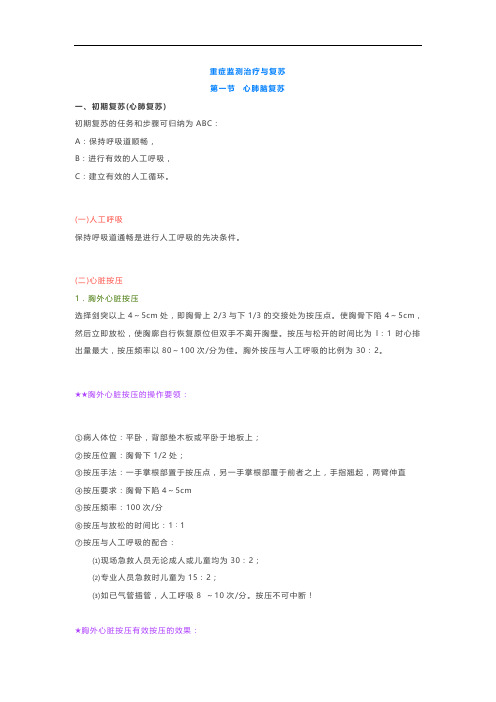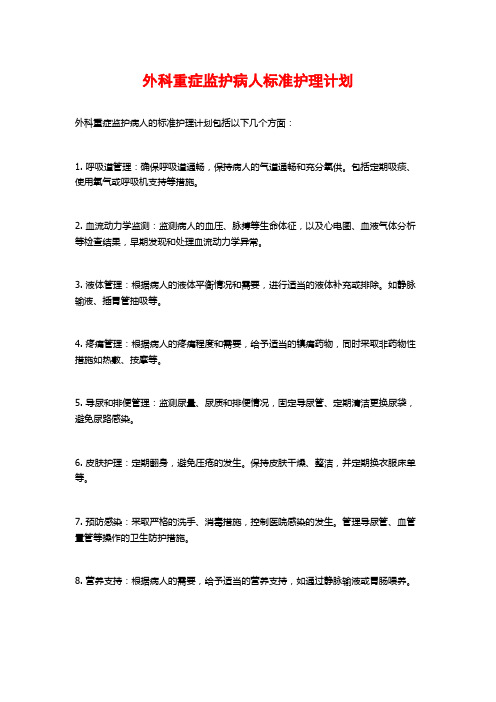外科重症监测治疗
重症监测治疗

重症监测治疗
26/42
(一)循环系统支持
(二)循环功效评价和治疗标准:在ICU维 持正常循环功效有赖于对心率、心律、 心脏前负荷、后负荷和心肌收缩性正确 评价和维持。
1、依据监测参数评价循环功效: 2、依据监测结果决定治疗标准
重症监测治疗
27/42
(二)呼吸系统支持
(一)呼吸功效监测: 围术期间主要是对肺通气功效、氧合功效和呼吸机
重症监测治疗
5/42
重症监测治疗发展轨迹
60年代对氧中毒概念认识、动 脉血气分析及低压套囊导管临 床应用,对提升呼吸衰竭治愈 率、降低并发症起到主要作用。
重症监测治疗
6/42
重症监测治疗发展轨迹
60年代以来,各种复杂手术开展, 心肺复苏技术提升,各种监测和 治疗仪器应用, 如Swan-Ganz 漂 浮导管、多功效监测仪、除颤器 和呼吸器等,使ICU得到深入发 展。
重症监测治疗
21/42
【ICU必配设备】
(六)其它设备:心电图机、血气分析仪、 除颤仪、血液净化仪、连续性血流动力学与 氧代谢监测设备、心肺复苏抢救装备车(车 上备有喉镜、气管导管、各种接头、抢救药 品以及其它抢救用具等)、体外起搏器、纤 维支气管镜、电子升降温设备等。
重症监测治疗
22/42
【ICU必配设备】
因为各种创伤、感染、器官功效障碍等,使 病人都处于不一样程度应激反应状态,为了 修复创伤和恢复器官功效,对能量需求显著 增加,结果引发代谢亢进。
危重病人往往不能正常地摄取营养,假如不 给予营养支持治疗,势必引发营养状态快速 恶化,这对于病情恢复是十分不利。
营养支持治疗目标是有效供给患者能量和营 养物质。
重症监测治疗
28/42
11c-重症监测治疗

三、血液动力学监测的临床应用
(二)根据监测结果决定基本治疗原则 从血流动力学和计算结果,可以判断心脏前负荷、后 负荷及心肌收缩性的状态,确定基本治疗原则。 Ø 肺毛细血管楔压(PCWP)低于10mmHg时,表示前负 荷降低,血容量不足,可参考红细胞比容和血浆胶体渗透 压补充晶体液、胶体液或全血。 Ø 当PCWP高于18mmHg时,可利用利尿药或血管扩张药使 其降低,可保护心肌,使CO增加。
三、血液动力学监测的临床应用
(二)根据监测结果决定基本治疗原则 Ø 当总外周血管阻力(TPR)<100kPa.s/L时,表示心脏后 负荷降低,应先补充血容量,必要时给予小量血管收缩药。 当TPR>200kPa.s/L时,后负荷增高。
Ø 当心肌收缩性降低,表现为心脏指数(CI)和左心室排血
做功指数(LVSWI)降低,可用正性心肌力药物治疗,必
• 以上三种模式都是强制通气方式。可能各个品牌的呼吸机
上名字不太一样,从A/C、CMV到IPPV,实际通气的内容 都是相似的。CV、CMV、IPPV三者为同一模式。 • 无论CV、AV还是A/C模式,都是既可以选择定压也可以 选择定容的。
• 在临床应用中,PCV和VCV实际上分别指定压型和定容型
的A/C模式。
功;对循环影响小;可更顺利脱机
PSV缺点: 是辅助通气方式,潮气量依病人的吸气力量而变化,分钟 通气量依潮气量和呼吸频率而定,如病人自主呼吸频率、 力量改变,有可能发生通气不足或过度。
呼吸中枢、呼吸运动不稳定者不宜单独使用,可与SIMV合
用。
二、呼吸功能的监测和呼吸治疗
(7)呼气末正压(PEEP) • 应用PEEP时,使呼气末的气道压及肺泡内压维持高于大 气压水平,可使小的开放肺泡 膨大,使萎陷肺泡再膨胀。 可以降低肺内分流量,纠正低氧血症。
外科护理学重点概述 第五章 重症病人的监护

第五章重症病人的监护第一节概述重点和难点问题重症监护室主要收治那些经过监测和积极治疗后有可能恢复的各类危重病人,包括:1.严重创伤、大手术及器官移植术后需要监测器官功能者。
2.各种原因引起的循环功能失代偿,需要以药物或特殊设备来支持其功能者。
3.有可能发生呼吸衰竭,需要严密监测呼吸功能,或需用呼吸机治疗者。
4.严重水、电解质及酸碱失衡者。
5.麻醉意外、心跳骤停复苏后治疗者。
第二节监护重点和难点问题一、心血管监护1.血压与脉搏监测当血容量、心脏收缩力和外周血管阻力改变时,血压和脉搏也随之改变。
(1)血压监测:有无创测压和有创测压两种方法。
无创测压是通过袖带连接监护仪的传感器,间接测量收缩压、舒张压和平均压。
有创测压是通过桡动脉直接穿刺插管或切开置管,连接压力换能器,再相连监护仪的传感器,直接测定收缩压、舒张压、平均压和动脉波型,主要用于外周血管阻力过高、严重休克、循环不稳定、大手术、大出血、脉压低及低温状态的病人。
(2)脉搏监测:可通过心电监护仪或扪诊的方法来监测。
脉搏快,但不超过120次/分,且有力,心输出量增加;若脉搏过快,且细弱,或低于50次/分,心输出量明显减少。
2.中心静脉压监测正常为0.59~1.18kPa(6~12cmH2O)。
根据中心静脉压的变化,结合血压、脉搏、尿量等指标进行综合分析,可判断血容量、心功能及外周阻力的状况。
3.心电监测包括心率和心律的监测,常通过指(趾)脉搏传感器或心电电极来完成。
(1)监测对象:①外科性休克、严重感染或创伤、水电解质失衡及心血管疾病的病人,尤其需要手术治疗者。
②接受心脏、胸腔或上腹部手术者。
③术中发生大出血或麻醉意外者。
④重症胰腺炎、急性腹膜炎及急性肾衰竭者。
(2)常见心律失常的处理措施:①心动过缓,如因椎管内麻醉或手术牵拉所致,可用阿托品静注;因血压过高引起者,使用降压药。
②心房扑动、心室纤颤、室性期前收缩、室性心律及传导阻滞,即刻报告医生、给氧、备好抢救物品(药品、起搏器及除颤器等)。
03、【外科学笔记】重症监测治疗与复苏

重症监测治疗与复苏第一节心肺脑复苏一、初期复苏(心肺复苏)初期复苏的任务和步骤可归纳为ABC:A:保持呼吸道顺畅,B:进行有效的人工呼吸,C:建立有效的人工循环。
(一)人工呼吸保持呼吸道通畅是进行人工呼吸的先决条件。
(二)心脏按压1.胸外心脏按压选择剑突以上4~5cm处,即胸骨上2/3与下1/3的交接处为按压点。
使胸骨下陷4~5cm,然后立即放松,使胸廓自行恢复原位但双手不离开胸壁。
按压与松开的时间比为l:1时心排出量最大,按压频率以80~100次/分为佳。
胸外按压与人工呼吸的比例为30:2。
★★胸外心脏按压的操作要领:①病人体位:平卧,背部垫木板或平卧于地板上;②按压位置:胸骨下1/2处;③按压手法:一手掌根部置于按压点,另一手掌根部覆于前者之上,手指翘起,两臂伸直④按压要求:胸骨下陷4~5cm⑤按压频率:100次/分⑥按压与放松的时间比:1∶1⑦按压与人工呼吸的配合:⑴现场急救人员无论成人或儿童均为30:2;⑵专业人员急救时儿童为15:2;⑶如已气管插管,人工呼吸8 ~10次/分。
按压不可中断!★胸外心脏按压有效按压的效果:①大动脉有搏动;②血压可达80~100mmHg;③ETCO2升高;④瞳孔变化。
2.开胸心脏按压开胸的切口位于左侧第4肋间,起于距离胸骨左缘2~2.5cm处,止于左腋前线。
开胸后术者将手掌伸进胸腔并将心脏托于掌心,以除拇指以外的四指握住心脏对准大鱼际肌群部位进行按压。
忌用指端着力,以免损伤心肌。
按压频率以60-80次为宜。
二、复苏后治疗脑复苏主要任务是防治脑水肿和颅内压升高,以减轻或避免脑组织的再灌注损伤,保护脑细胞功能。
★防治急性脑水肿的措施:①降温;②脱水;③肾上腺皮质激素治疗。
外科学课件:第七章 重症监测治疗与复苏

2、呼吸系统
(1)呼吸功能监测
潮气量:VT 呼吸频率:RR 动脉血氧饱和度:SaO2 动脉血氧分压:PaO2 动脉血CO2分压: PaCO2
氧合指数: PaO2/FiO2 肺活量:VC
6~10(ml/Kg) 12~20
(96~100%) (80~100mmHg) (35~40mmHg)
(>300)
第二节 心肺脑复苏(CPCR)
(一)尽早识别心搏骤停和启动紧急医疗服务系 统(EMSs)
(二)尽早开始CPR 顺序:C-A-B 1、心脏按压:(1)胸外心脏按压:体位、部位、
手法、深度、频率。人工呼吸比:30:2
(2)开胸心脏按压:首选指征和一般指征
2、人工呼吸 (1)呼吸道管理:手法 (2)徒手人工呼吸:注意事项 (3)简易人工呼吸器和机械通气
(三) 恢复期
肾小球滤过功能多在3~6个月恢复; 少数病例遗留永久性肾损害,肾组织纤维化而 转变为慢性肾功能不全。
(四)、AKI早期诊断标记物
1、血清半胱氨酸蛋白酶抑制剂 2、肾损伤分子 3、中性粒细胞明胶酶等 (五)肾穿刺活检
四、治疗
第七章 重症监测治疗与复苏
第一节 重症监测治疗
重症监护病房( intensive care unit, ICU) 是医院集中监护和救治重症病人的专业科室( 床 位数;医疗设施;人数相应床数)
重症医学(critical care medicine,CCM)
研究危及生命的疾病状态的发生、发展规律及其 诊治方法的临床医学学无量化指标 2)血乳酸浓度:≤2mmol/L,>4mmol/L,48H以
上预后不良 3)混合静脉血氧饱和度(SvO2):70%~75% ,
(ScvO2):70%~80% 4)胃黏膜内CO2分压(PgCO2):<45mmHg;P( G-a)CO2 <9mmHg;值越大,表示胃组织缺氧越严
神经外科重症监护

四、收治理病人标准
1、手术前、后的危重病人
2、重型颅脑外伤患者 3、术后发生严重并发症者,如多器官
功能衰竭 4、气管切开患者 5、开颅术后病人麻醉苏醒期 6、需亚低温治疗的患者
五、工作程序
(1)转入病人时
①检查病人气道是否通畅 ②遵医嘱给予病人吸氧,需要机械通气支 持呼吸时,按医嘱校正呼吸机后与病人 连接 ③将监护仪器与病人连接,并检查检测仪 使用情况,调好报警值线,打开报警 ④用听诊器听心律1分钟,以检查监测仪 器是否正确 ⑤检查静脉通路
5、肾功能、水电解质平衡监测
检查血清肌酐、尿素氮含量、监测血离
子、垂体瘤、颅咽管瘤、鞍区肿瘤、术 中损伤垂体柄、牵拉下丘脑、尿比重、 PH值、蛋白定量、24小时出入量,血 清钾、钠、氯等。
6.体液失衡纠正及营养支持
(1)由于失血、内分泌紊乱、高热等, 可导致脱水、低钠或高钠、低钾或高钾, 严重者可出现酸中毒或碱中毒,加重循 环、呼吸、肝肾功能障碍,需及时纠正。
格拉斯哥昏迷分级
睁眼反应 计分 言语反应 自动睁眼 呼唤睁眼 4 3 回答正确 回答错误 计分 5 4 运动反应 计分 遵医嘱活动 6 刺痛定位 5
刺痛睁眼
不能睁眼
2
1
语无伦次
只能发声 不能发声
3
2 1
躲避刺痛
刺痛肢曲 刺痛肢伸 不能活动
4
3 2 1
2.体温监测
(1)中枢性体温升高 常见于脑干损伤、
术中大出血等,应及时补充血容量及胶 体溶液。 心血管调节中枢受损而引起的血压下降 者应给予升压治疗。
4、呼吸功能监测
主要包括呼吸频率和潮气量两方面。导
致神经外科病人呼吸功能异常的主要病 变有重型颅脑损伤、肿瘤病变累及下丘 脑、脑干呼吸中枢、出血性脑血管疾患 心及术后麻醉未清醒的病人、继发肺部 感染的病人等。
神经外科重症患者的监护

案例一:脑外伤重症患者的监护
总结词
脑外伤重症患者需要密切监测生命体征、意识状态和颅内压等指标,及时发现 并处理并发症。
详细描述
脑外伤重症患者通常会出现意识障碍、颅内压升高、脑水肿等症状,需要密切 监测病情变化,及时调整治疗方案,如药物治疗、手术干预等。同时,还需要 注意患者的营养、心理等方面的护理,促进康复。
褥疮是神经外科重症患者 常见的并发症,可能导致 感染、败血症等严重后果 。
定时为患者翻身,减轻局 部受压,促进血液循环。
使用气垫床、泡沫垫等辅 助工具,减轻患者与床面 的接触压力。
保证患者的营养摄入,提 高身体抵抗力。
对于已经形成的褥疮,应 及时清创、换药和处理, 避免感染扩散。
REPORT
CATALOG
加强护理
保持患者皮肤、口腔和泌尿系统的清洁卫生, 减少感染源。
预防性使用抗生素
根据患者的病情和感染风险,预防性使用抗 生素。
及时诊断与治疗
对于已经发生的感染,应及时诊断并使用适 当的抗生素进行治疗。
褥疮的预防与处理
01
02
03
04
05
总结词
定期翻身
使用气垫床、泡 沫垫等辅…
加强营养支持
及时处理创面
注意事项
在给药过程中,应密切观察患者的反应,及时调整药物剂 量和给药方式;同时注意药物的相互作用和配伍禁忌,避 免不良反应的发生。
不良反应观察与处理
镇静剂不良反应
包括呼吸抑制、低血压、心律失常等,应 注意观察患者的呼吸、血压和心电图变化,
及时处理。
抗癫痫药物不良反应
包括认知障碍、肝功能损害、过敏反应等, 应注意监测患者的认知功能、肝功能和过 敏反应情况,及时处理。
神经外科术后重症监护

神经外科手术涉及颅脑等重要部位,术后可能出现严重的并发症和生命危险。 重症监护能够及时发现问题,采取有效措施,降低死亡率,提高患者生存质量 。
神经外科术后重症特点
病情复杂多变
神经外科术后患者可能出现颅内压增高、脑水肿、脑出血等多种 严重并发症,病情复杂且变化迅速。
需要高度专业化的医疗团队
神经外科术后重症监护需要由经验丰富的神经外科医生、重症医学 科医生、护士等多学科专业人员组成的团队进行。
依赖先进的监测和治疗设备
神经外科术后重症监护需要使用颅内压监测、脑电图、呼吸机、血 液透析等先进设备,确保患者得到精准治疗。
监护目标与原则
监护目标
确保神经外科术后患者的生命安全, 及时发现并处理并发症,促进患者康 复。
MRI检查
对软组织分辨率高,可清 晰显示病变与周围组织的 关系,有助于评估手术效 果和预测预后。
DSA检查
即数字减影血管造影,可 显示颅内血管的形态、分 布和走行,用于评估血管 病变和手术效果。
03 呼吸系统管理与支持
呼吸道管理
保持呼吸道通畅
定期清理呼吸道分泌物, 确保呼吸道畅通,防止窒 息和肺部感染。
药物治疗
使用抗凝药物预防血栓 形成,降低深静脉血栓 的发生率。
物理预防
使用弹力袜、间歇充气 加压装置等物理方法预 防深静脉血栓的形成。
THANKS
02 神经系统评估与监测
意识状态评估
意识状态分级
根据患者的觉醒程度、意识内容 及意识范围,可分为清醒、嗜睡 、昏睡、昏迷等状态。
GCS评分
即格拉斯哥昏迷评分,通过睁眼 、言语和运动三方面的反应来评 估患者意识障碍的程度。
颅内压监测
外科重症监护病人标准护理计划

外科重症监护病人标准护理计划
外科重症监护病人的标准护理计划包括以下几个方面:
1. 呼吸道管理:确保呼吸道通畅,保持病人的气道通畅和充分氧供。
包括定期吸痰、使用氧气或呼吸机支持等措施。
2. 血流动力学监测:监测病人的血压、脉搏等生命体征,以及心电图、血液气体分析等检查结果,早期发现和处理血流动力学异常。
3. 液体管理:根据病人的液体平衡情况和需要,进行适当的液体补充或排除。
如静脉输液、插胃管抽吸等。
4. 疼痛管理:根据病人的疼痛程度和需要,给予适当的镇痛药物,同时采取非药物性措施如热敷、按摩等。
5. 导尿和排便管理:监测尿量、尿质和排便情况,固定导尿管、定期清洁更换尿袋,避免尿路感染。
6. 皮肤护理:定期翻身,避免压疮的发生。
保持皮肤干燥、整洁,并定期换衣服床单等。
7. 预防感染:采取严格的洗手、消毒措施,控制医院感染的发生。
管理导尿管、血管置管等操作的卫生防护措施。
8. 营养支持:根据病人的需要,给予适当的营养支持,如通过静脉输液或胃肠喂养。
9. 情绪支持:给予病人适当的情绪支持和关心,帮助其减轻焦虑和压力。
同时与病人及家属进行有效沟通,提供必要的指导和教育。
10. 定期评估和记录:对病人的生命体征、治疗效果进行定期评估和记录,以便及时调整护理措施和治疗方案。
以上是外科重症监护病人标准护理计划的基本内容,具体操作还需要根据病情和医嘱进行调整和执行。
重症监测

初期复苏(BLS)
C : Circulation – 建立有效的人工循环
呼吸循环骤停诊断:
神志突然消失,大动脉搏动消失及无自主呼吸
表现形式:1.心室停顿(Ventricular standstill)
2.心室纤颤(Ventricular fibrillation) 3.电-机械分离(Electro-mechanical dissociation)
重症监测治疗与复苏
杭州师范学院临床医学院科教研室 施伟
第一节 重症监测治疗病 室intensive care unit ( ICU
)
ICU的特点
是医院中危重病人集中管理的场所
具一支对危重病进行紧急救治的医护队伍 配备先进的检测技术 具备先进的治疗技术
ICU的体制和建设
体制
工作内容
收治对象 1.危重病人 2.经积极治疗能获得成功
适应症 各种术后危重病 必须呼吸支持的病人 心衰,各种低排综合征或严重心律失常 各类休克 严重代谢障碍
急性肾功能障碍 器官移植急性药物中毒 其他经短期强化治疗可望恢复的急性衰竭病人
非适应症 脑死亡病人 急性传染病 恶性肿瘤晚期 并无急性危象的慢性病人;老死病人
开放呼吸道 原因:舌后坠 异物或呕吐物、分泌物 方法:仰头举颏 托起下颌 清除异物或分泌物 放置通气道或气管内插管 视、触和听诊 – 无呼吸,则进入下一步
初期复苏(BLS)
B – 进行有效人工呼吸
如果开放气道后,受害人仍无适当呼吸,则启动辅助通气。
1.徒手人工呼吸法
包括口对口、口对鼻、口对口鼻、口对面罩等 方法:一手使头后仰,托起下颌 另一手压前额,拇指与示指捏闭病人鼻孔 深吸气,用力吹气; 实施:先缓慢吹气(小潮气量)2次 然后,5秒钟吹气1次。 效果:观察胸廓起伏、吹气阻力等判断
- 1、下载文档前请自行甄别文档内容的完整性,平台不提供额外的编辑、内容补充、找答案等附加服务。
- 2、"仅部分预览"的文档,不可在线预览部分如存在完整性等问题,可反馈申请退款(可完整预览的文档不适用该条件!)。
- 3、如文档侵犯您的权益,请联系客服反馈,我们会尽快为您处理(人工客服工作时间:9:00-18:30)。
Why are scoring systems needed?
❖ Scoring systems can provide:
-Defining population of critically ill pts
- A tool for comparative audit - A mechanism to decide
ICU收治对象-外科重危病人
❖创伤、大手术 ❖器官移植后监测 ❖循环失代偿者 ❖有呼吸衰竭可能,需呼吸器治疗者 ❖严重水电解质紊乱,酸碱平衡失调者 ❖麻醉意外、心肺复苏后病人 ❖单个或多个器官功能不全者 ❖严重代谢障碍性疾病(甲亢、肾上腺、垂体危象)
Intensive care 外科重症监测治疗
What is ICU?
❖ An intensive care unit (ICU) is a specially staffed and equipped hospital ward dedicated to the management of patients with lifethreatening illnesses,injuries or complications.
❖Hemodynamic support -inotrope and vasoactive medication
❖Mechanical ventilation ❖Organ support (eg.dialysis) ❖Sedation and analgesia ❖Treatment of underlying illnesses ❖Enteral/parenteral nutrition
❖ the MPM (mortality probability model), ❖ the SAPS (simplified acute physiology
score) system. These were all designed to predict outcomes in critical illness and use severity-of-illness scoring systems with common variables. ❖ These include age; vital signs; assessments of respiratory, renal, and neurologic function; and an evaluation of chronic medical illnesses
cost
❖ICU is generally the most expensive, technologically advanced and resource intensive area of medical care. In the United States estimates of the 2000 expenditure for critical care medicine ranged from US$15-55 billion accounting for about 0.5% of GDP and about 13% of national health care expenditure (Halpern, 2004).
❖治疗设备:呼吸机、除颤器、输液泵、注射泵、起 搏器、主动脉内球囊反搏器、血液净化仪、麻醉 机、中心供氧、中心吸引装置、体外膜式肺氧合 (ECMO)装 。
监护仪
❖ 心功能监测系统
心电图机
便携式血气电解质肾功检验仪
铁肺—重症监护病房的最早尝试
呼吸机
Defibrillator 除颤器
制氧机
❖ Pulse Oxymetry ❖ 血氧饱和仪
❖ 1952年夏,丹麦哥本哈根脊灰流行,造成延髓性呼吸麻痹, 多死于呼吸衰竭。病人被集中,通过气管切开保持呼吸道畅 通并进行肺部人工通气,使死亡率显著下降。治疗效果的改 善,使有关医生认识到加强监护和治疗的重要性。
Type of ICU patients
William Osler 1849-1919
History
❖ 1953 – Virginia Apgar ❖ 1974 – Glasgow Coma Scale
❖ APACHE & SAPS – physiologically based classification systems
❖ General severity scores ❖ Aim at stratifying patients based on their severity ❖ 1985 – 1993: general outcome prediction models ❖ 1991 – APACHE III ❖ 1993 – SAPS II ❖ 2005 – SAPS III ❖ 2006 – APACHE IV ❖ During process of evolution of models, main prognostic
Gerneral ICU ward
ICU equipment
❖监测设备monitoring equipment :多功能生
命体征监测仪、呼吸功能监测仪、心脏血流动力 学监测仪、脉搏血氧饱和度仪、血气分析仪、心 电图机。
▪ 监护仪器按系统或器官功能参数分门排列,左 列显示功能参数,右列为治疗参数。
What do we do in ICU?
monitoring ❖ECG heart rate, rhythm, ischemia ❖Blood pressure
non-invasive invasive arterial,central venous, pulmonary artery ❖Hemodynamic measurement
❖ 重症监护病房(intensive care unit, ICU)是将 疑难危重患者集中监测治疗的单位。
History of ICU
❖ICU developed from the poliomyelitis脊 髓灰质炎epidemic in the early 1950s,when the use of long-term artificial ventilation resulted in reduced mortality. Mortality of polio epidemic 87% Dropped to 27% by the use of anesthesia machines for ventilation of pts
Assessment of Severity of Illness--History
❖ APACHE & SAPS – physiologically based classification systems
❖ General severity scores ❖ Aim at stratifying patients based on their severity ❖ 1985 – 1993: general outcome prediction models ❖ 1991 – APACHE III ❖ 1993 – SAPS II ❖ 2005 – SAPS III ❖ 2006 – APACHE IV ❖ During process of evolution of models, main prognostic
resource allocation - An aid for the clinical
management of patients
“It’s more important to know se has, than what sort of disease this person has.”
APACHE
❖William Knaus ❖Initially 34 physiological variables ❖1985 – APACHE II 12 variables ❖APACHE II allows probability of death
before hospital discharge to be estimated ❖Standardised mortality ratio
cardiac output
❖Pulse oxymetry and capnography ❖Intracranial,intraabdominal pressure ❖Many others electrolyte, CNS
What do we do in ICU?--Treatment
❖Terminal illness or irreversible ❖Terminal cancer ❖Permanent brain damage
❖Infectious disease? SARS√ --management of mechanically ventilated
severe acute respiratory syndrome (SARS) patients in the isolation intensive care unit (ICU)--successful
determinants of outcome changed
Scoring System
❖The most commonly utilized scoring systems are
❖the APACHE (acute physiology and chronic health evaluation) system,
❖ Standardised mortality ratio
APACHE
❖acute physiology and chronic health evaluation ❖APACHEⅡ 0~71
